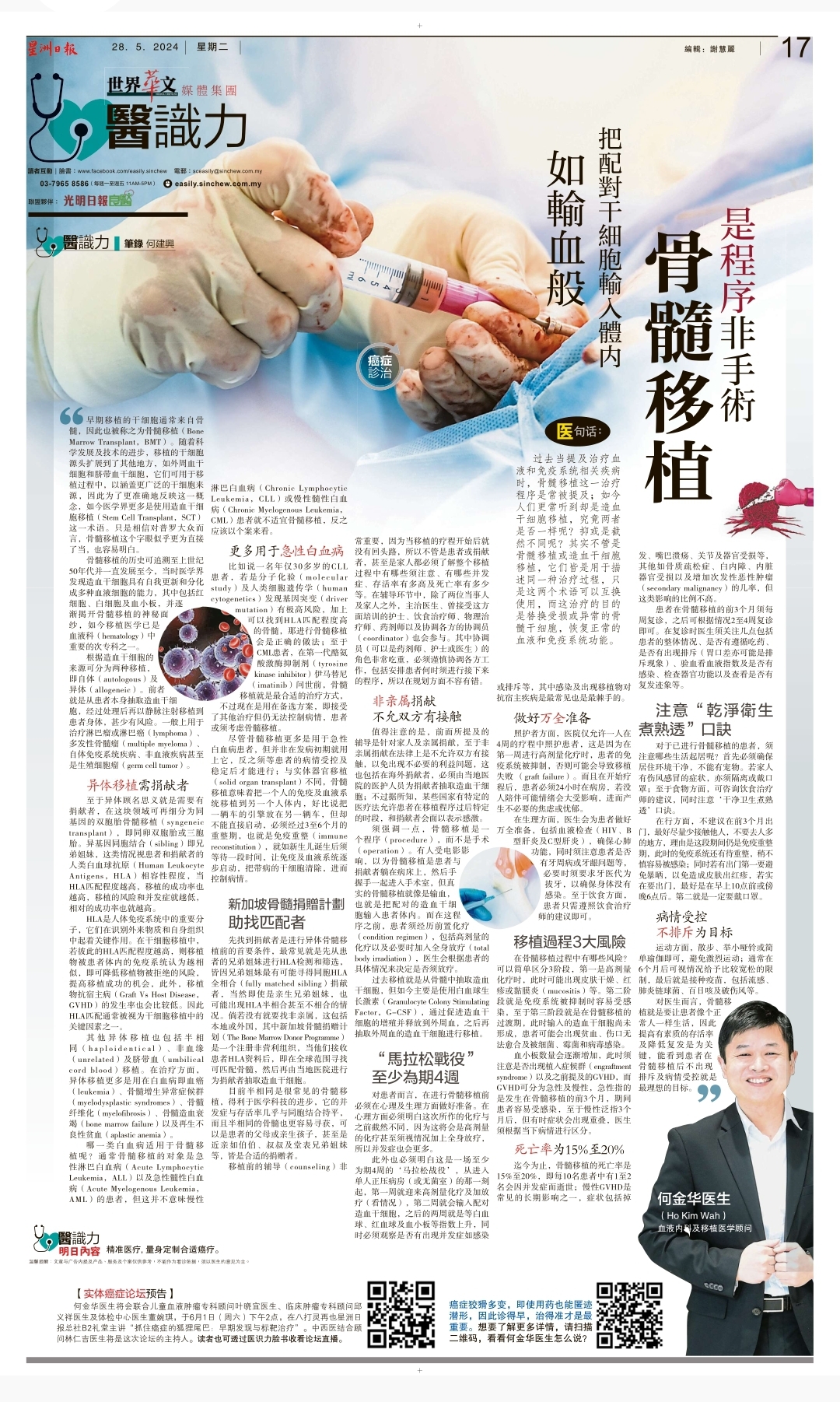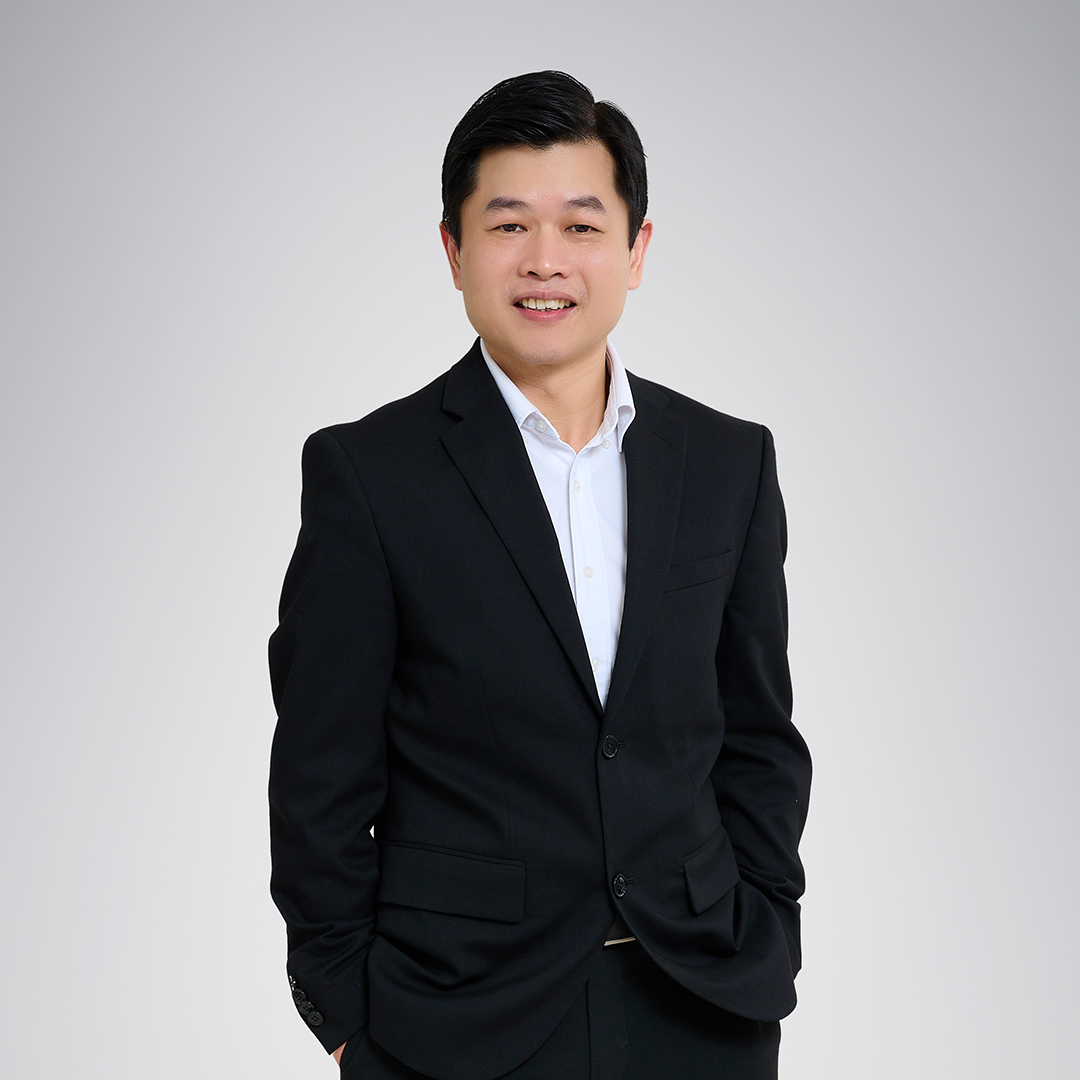Stem Cell Transplantation is a Procedure, Not a Surgery, Like a Blood Transfusion of Matched Stem Cells
28 May 2024

Bone marrow transplantation used to be a common procedure when talking about treating diseases related to the blood and immune system, but nowadays people hear about haematopoietic stem cell transplantation, so are they the same? Are they the same, or are they very different? In fact, both bone marrow transplantation and haematopoietic stem cell transplantation are used interchangeably to describe the same treatment, which aims to replace damaged or abnormal bone marrow stem cells and restore normal blood and immune system function.
"Early transplants of stem cells were usually from the bone marrow, hence the term Bone Marrow Transplant (BMT). With scientific developments and technological advances, the source of stem cells for transplantation expanded to include other places such as peripheral blood stem cells and umbilical cord blood stem cells, which can be used in the transplantation process to encompass a wider range of stem cell sources, and therefore to reflect the concept more accurately, the term Stem Cell Transplant (SCT) is more commonly used in the medical community today.
There are two types of transplants based on the source of the haematopoietic stem cells, namely autologous and allogeneic. In the former case, haematopoietic stem cells are extracted from the patient, processed and then transplanted intravenously into the patient's body with little risk. It is generally used for the treatment of lymphoma, multiple myeloma, autoimmune diseases, non-haematological diseases and even germ cell tumours.
Allogeneic transplantation requires a donor
Allogeneic means that a donor is required, and in this area it can be subdivided into syngeneic transplant, i.e. identical twins or triplets. Allogeneic sibling, i.e. brothers and sisters, are cases where, depending on the degree of Human Leukocyte Antigens (HLA) compatibility between the patient and the donor, the higher the HLA match, the higher the success rate of the transplant, the lower the risks and complications of the transplant, and the higher the relative success rate.
Other allogeneic transplants include haploidentical, unrelated and umbilical cord blood transplants. Therapeutically, allogeneic transplants are more commonly used for leukemia, myelodysplastic syndromes, myelofibrosis, bone marrow failure, and aplastic anemia. aplastic anemia.)
Which types of leukaemia are suitable for bone marrow transplantation? Bone marrow transplantation is usually indicated for patients with Acute Lymphocytic Leukemia (ALL) and Acute Myelogenous Leukemia (AML), but this does not mean that Chronic Lymphocytic Leukemia (CLL) or Chronic Myelogenous Leukemia (CML) are not indicated. However, this does not mean that patients with Chronic Lymphocytic Leukemia (CLL) or Chronic Myelogenous Leukemia (CML) are not suitable for bone marrow transplantation, rather it should be viewed on a case by case basis.
 More commonly used in acute leukaemia
More commonly used in acute leukaemia
Although bone marrow transplantation is more commonly used for acute leukaemia patients, it is not used at the beginning of the disease, but only after the patient's condition has been controlled and stabilised; unlike solid organ transplantation, bone marrow transplantation implies that a person's immune and blood systems are transplanted into another person's body, which is similar to placing the engine of a car into another car. However, it cannot be started straight away, but has to go through a 3 to 6 months reconstitution period, also known as immune reconstitution, as in the case of a newborn baby who has to wait for a period of time after birth to allow the immune and blood systems to kick in gradually to get rid of the disease-carrying stem cells, and then to control the disease.
Singapore Bone Marrow Donor Programme helps find a match
Finding a donor is the first step before proceeding with an allogeneic bone marrow transplant. Most commonly, HLA testing and screening is done on the siblings of the patient, as siblings are the most likely to find a fully matched sibling, although even biological siblings may be half-matched or even unmatched. If not, we have to look for non-relatives, both local and foreign, including The Bone Marrow Donor Programme (BMDP), a registered non-profit organisation in Singapore, which, upon receipt of the patient's HLA profile, conducts a worldwide search for a bone marrow match, and then a local hospital conducts the harvesting of the donor's haematopoietic stem cells.
Hemi-identical bone marrow is now a very common form of bone marrow transplantation. Thanks to advances in medical technology, the complications and survival rates are almost the same as those of siblings, and hemi-identical bone marrow is much easier to find, as it can be from the patient's parents or biological children, or even from close relatives such as aunts, uncles, and first cousins, etc., and they are suitable donors.
Pre-transplant counselling is very important as there is no turning back once the transplantation process has begun, so it is important for both the patient and the donor, and even family members, to understand what to watch out for during the entire transplantation process, what the complications are, what the survival rate is, and what the mortality rate is.
Non-Relative Donors are not allowed to have contact with each other
It is worth noting that the counselling mentioned above is for family and relatives, while non-relative donors are not legally allowed to have contact with each other in order to avoid unnecessary problems of interest, including overseas donors, who must have their haematopoietic stem cells extracted by local hospital staff; however, it is known that in some countries, there are specific medical laws that allow patients to meet with the donor at a specific time after the transplantation procedure in order to express gratitude. However, it is known that in some countries there are specific medical laws that allow the patient to meet with the donor at a specific time after the transplant procedure to show their appreciation.
It should be emphasised that bone marrow transplantation is a procedure, not an operation. Some people are influenced by films to think that a bone marrow transplant involves the patient and donor lying in a hospital bed and going into the operating theatre together, holding hands, but a real bone marrow transplant is like a blood transfusion, where matched blood stem cells are put into the patient's body. Before this procedure, the patient undergoes a condition regimen, which includes high-dose chemotherapy and, if necessary, total body irradiation, which is determined on a case-by-case basis.
In the past, transplantation involved taking blood stem cells from the bone marrow, but nowadays, the main method is to use Granulocyte Colony Stimulating Factor (G-CSF), which promotes the proliferation of blood stem cells and releases them into the peripheral blood, after which blood stem cells from the peripheral blood are taken out for transplantation.
Be aware of the motto of "clean, hygienic and well-cooked"
For patients who have undergone bone marrow transplant, what should they pay attention to in their daily life? Firstly, you must make sure that your living environment is clean and there are no pets. If family members have cold or flu symptoms, they should be isolated or wear masks. As for food, consult a dietitian for advice and pay attention to the motto of "cook well".
In terms of travelling, it is not recommended to go out in the first 3 months, and it is best to minimise contact with others and not to go to crowded places, as this is still the period of immune re-structuring and the immune system is still to be re-structured at this time, so it is easy to get infected if you are not careful; at the same time, if you go out, first of all, you have to avoid exposure to sunlight, so as to avoid skin rashes, and if you really have to go out, it is best to go out in the morning before 10 am or in the evening after 6 pm. If you do go out, it is best to go out before 10am or after 6pm. Secondly, you must wear a mask.
Source: Sin Chew Daily





